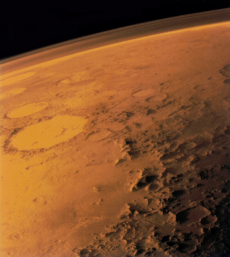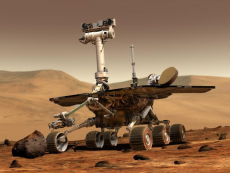
Mars is the fourth planet from the Sun, and is the second smallest after Mercury. It’s named for the Roman god of war, but is also known as the ‘red planet’ due to the high amount of iron oxide on its surface. It is similar to Earth in a number of ways: it has surface features like volcanoes, valleys, deserts and polar ice caps. It also rotates around the Sun on a tilt similar to ours, and so has similar season lengths. Mars is home to the Olympic Mons which is the largest volcano in the entire solar system, and the second highest mountain—it’s almost three times as tall as Mount Everest’s height about sea level!
Mars has long been the subject of human fascination, and has been charted by astronomers since 1534 BC. In 1877 an Italian astronomer named Schiaparelli noted the appearance of straight lines on the planet’s surface. He declared that these were canals and evidence of intelligent life, but it was later proved that what he saw was nothing more than an optical illusion (telescopes in the 19th century weren’t all that great). However, peoples’ interest was piqued, and since then we’ve been even more determined to explore the red planet.
This is a notoriously difficult feat, not least because of its great distance from Earth—around 140 million miles. To date roughly two thirds of all spacecraft destined for Mars have failed before completing their missions, with many failing before any scientific observations could take place.

Important events in Mars exploration
1965- The first successful fly-by completed by NASA’s Mariner 4. It captured the first pictures of the Martian surface. The images, which showed craters, and the measurements confirming a thin atmosphere, proved that Mars was an inactive planet and exposed to space. This destroyed hopes of finding intelligent life on Mars—any life would be a smaller, simpler form.
1971- NASA’s Mariner 9 became the first space probe to orbit another planet. It returned over seven thousand images over the course of its nearly year-long mission.
-Later the same year two Soviet probes became the first to make contact with the planet’s surface. Sadly they both crash landed.
1976- NASA’s Viking Program was the first to have a successful soft landing on the planet’s surface. Each was composed of an orbiter which stayed in the atmosphere, and a lander which explored the surface.
The orbiters returned the first colour panoramas of Mars, and made important observations about the planet’s surface. The photographs showed huge geographical forms typically formed from large volumes of water: huge river valleys in the northern hemisphere, while areas in the south contained branched stream networks suggesting previous rainfall.
Meanwhile the landers performed a variety of biological experiments to detect organic (living) matter in Martian soil: sadly these were inconclusive.
1996- NASA’s Mars Global Surveyor mapped the entire planet for the first time. From 1997 to 2006 it took more than 240,000 images.
2004- The Spirit and Opportunity Rovers (pictured) provided the first conclusive evidence that liquid water once existed on the planet. Amazingly, the Opportunity Rover is still active on Mars today—it’s been running for more than 45 times its designed lifespan!
2008- The Phoenix rover was the first successful landing in a Martian polar region, and confirmed the existence of water ice.
2011- The Curiosity rover began several investigations on the planet’s surface, including whether Mars has ever provided suitable conditions for microbes and small organisms, and whether it will ever be suitable for human exploration.
2013- India’s Mars Orbiter Mission made it the first country to reach Mars’ orbit on a first attempt. At $73 million it’s also the cheapest Mars mission to date.
Human exploration and possible colonisation of Mars continues to be a fascinating subject. However, there are many possible problems, not least the extremely high cost this would entail. Contamination is another issue, both of the planet’s surface by human microbes, and possible back-contamination of Earth by Martian microbes (should they exist!) A round trip to Mars would take a minimum of 400 days, but in order to be worthwhile would probably be much longer. The psychological effects of isolation from Earth, together with the possible physical effects of high radiation doses, pose serious challenges.
It’s long been said that it would be considerably less difficult and expensive to undertake a one-way trip to Mars. This was the idea behind the widely-publicised Mars One mission announced in 2012, which proposed to have a human colony on the planet by 2027. The selection of candidates was widely reported in the media, as well as the possible funding option of a Mars reality television show. However, the enterprise has suffered criticism, with many scientists dismissing it as unrealistic. Both NASA and the European Space Agency have long-term plans to send humans to Mars by the 2030s.
Images: https://upload.wikimedia.org/wikipedia/commons/c/cd/Mars_atmosphere_2.jpg
http://photojournal.jpl.nasa.gov/jpegMod/PIA04413_modest.jpg

0 Comment:
Be the first one to comment on this article.